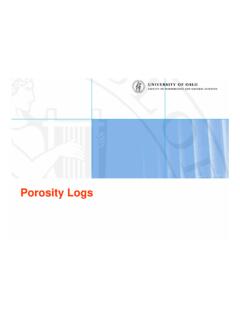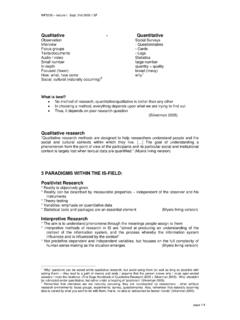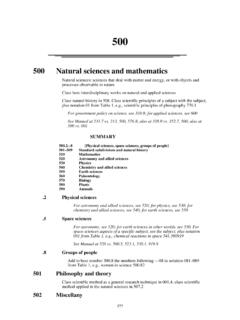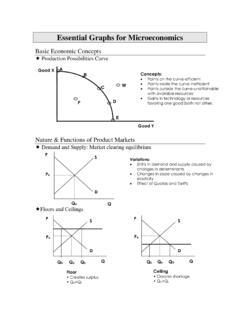Transcription of DATA ANALYSIS, INTERPRETATION AND PRESENTATION
1 DATA ANALYSIS, INTERPRETATION AND PRESENTATIONOVERVIEW Qualitative and quantitative Simple quantitative analysis Simple qualitative analysis Tools to support data analysis Theoretical frameworks: grounded theory , distributed cognition, activity theory Presenting the findings: rigorous notations, stories, summariesWHY DO WE ANALYZE DATAThe purpose of analysing data is to obtain usable and useful information. The analysis, irrespective of whether the data is qualitative or quantitative, may: describe and summarise the data identify relationships between variables compare variables identify the difference between variables forecast outcomesSCALES OF , :thedatacanbeclassifiedintoanon-numerica lornamedcategories, scaleAn ordinal scale is where:the data can be classified into non-numerical or named categoriesan inherent order exists among the response scales are seen in questions that call for ratings of quality (for example, very good, good, fair, poor, very poor) and agreement (for example, strongly agree, agree, disagree, strongly disagree).
2 Numerical scaleA numerical scale is:where numbers represent the possible response categories there is a natural ranking of the categorieszero on the scale has meaningthere is a quantifiable difference within categories and between consecutive using a quantitative methodology, you are normally testing theory through the testing of a hypothesis. In qualitative research, you are either exploring the application of a theory or model in a different context or are hoping for a theory or a model to emerge from the data. In other words, although you may have some ideas about your topic, you are also looking for ideas, concepts and attitudes often from experts or practitioners in the REPRESENTATIONS give overview of dataNumber of errors of errors madeInternet use< once a dayonce a dayonce a week2 or 3 times a weekonce a monthNumber of errors made024681005101520 UserNumber of errors madeVisualizing log dataInteraction profiles of players in online gameLog of web page activityQUALITATIVE ANALYSIS"Data analysis is the process of bringing order, structure and meaning to the mass of collected data.
3 It is a messy, ambiguous, time-consuming, creative, and fascinating process. It does not proceed in a linear fashion; it is not neat. Qualitative data analysis is a search for general statements about relationships among categories of data."Marshall and Rossman, 1990:111 Hitchcock and Hughes take this one step further:"..the ways in which the researcher moves from a description of what is the case to an explanation of why what is the case is the case."Hitchcock and Hughes 1995:295 Simple qualitative analysis Unstructured -are not directed by a script. Rich but not replicable. Structured -are tightly scripted, often like a questionnaire. Replicable but may lack richness. Semi-structured -guided by a script but interesting issues can be explored in more depth. Can provide a good balance between richness and qualitative analysis Recurring patterns or themes Emergent from data, dependent on observation framework if used Categorizingdata Categorization scheme may be emergent or pre-specified Looking for critical incidents Helps to focus in on key eventsTOOLS TO SUPPORT DATA ANALYSIS Spreadsheet simple to use, basic graphs Statistical packages, SPSS Qualitative data analysis tools Categorization and theme-based analysis, N6 Quantitative analysis of text-based data CAQDAS Networking Project, based at the University of Surrey ( )Theoretical frameworks for qualitative analysis Basing data analysis around theoretical frameworks provides further insight Three such frameworks are.
4 Grounded theory Distributed Cognition Activity TheoryGrounded theory Aims to derive theory from systematic analysis of data Based on categorization approach (called here coding ) Three levels of coding Open: identify categories Axial: flesh out and link to subcategories Selective: form theoretical scheme Researchers are encouraged to draw on own theoretical backgrounds to inform analysisDistributed Cognition The people, environment & artefacts are regarded as one cognitive system Used for analyzing collaborative work Focuses on information propagation & transformationActivity theory Explains human behavior in terms of our practical activity with the world Provides a framework that focuses analysis around the concept of an activity and helps to identify tensions between the different elements of the system Two key models: one outlines what constitutes an activity.
5 One models the mediating role of artifactsIndividual modelEngestr m s (1999) activity system modelPresenting the findings Only make claims that your data can support The best way to present your findings depends on the audience, the purpose, and the data gathering and analysis undertaken Graphical representations (as discussed above) may be appropriate for PRESENTATION Other techniques are: Rigorous notations, UML Using stories, to create scenarios Summarizing the findingsSUMMARY The data analysis that can be done depends on the data gathering that was done Qualitative and quantitative data may be gathered from any of the three main data gathering approaches Percentages and averages are commonly used in Interaction Design Mean, median and mode are different kinds of average and can have very different answers for the same set of data Grounded theory , Distributed Cognition and Activity theory are theoretical frameworks to support data analysis PRESENTATION of the findings should not overstate the evidenc













